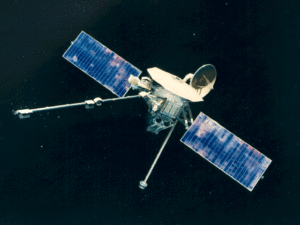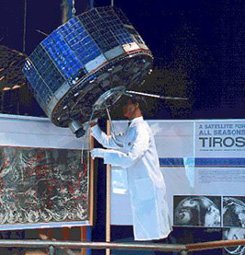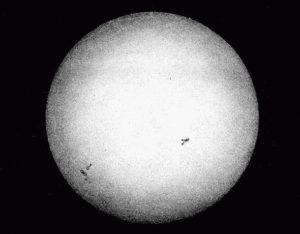
Photo: A mosaic of Mercury images taken by the Mariner 10 spacecraft during its approach on March 29, 1974 | NASA
March 29, 1974: Mariner 10 becomes the first space probe to fly by Mercury

The Mariner 10 space probe | NASA
Mariner 10 was a space probe launched by NASA on November 3, 1973. It was the final interplanetary space probe to be launched as part of the Mariner program, a 10-mission program with a goal of investigating Mars, Venus, and Mercury. Mariner 10 became the first space probe to fly by Mercury on March 29, 1974, 4 months and 27 days after it was launched.
During the flyby, Mariner 10 gathered vital measurements of Mercury’s environment, atmosphere, surface, and body characteristics. It also discovered evidence of a weak magnetic field around the planet, an atmosphere consisting primarily of helium, and evidence of rotating clouds in its stratosphere. The spacecraft flew past Mercury 3 times and took more than 2,800 photos that revealed a surface similar to that of Earth’s Moon. With its maneuvering gas supplies tapped, Mariner 10 began an orbit around the Sun as NASA lost contact with it. It is thought to still be orbiting the Sun today.

A prototype of the TIROS-1 weather satellite on display at the Smithsonian National Air and Space Museum | Public Domain
April 1, 1960: TIROS-1 weather satellite launched
The TIROS ((Television Infrared Observation Satellite) Program was NASA’s first attempt to create satellites capable of monitoring and predicting weather conditions on Earth. TIROS-1 was the first in a series of weather satellites to be launched into Earth’s atmosphere, where it relayed thousands of images of cloud structures back to mission control. TIROS-1 was only operational for 78 days, but it successfully proved that satellites, then a fairly new technology, could be a useful tools for surveying global weather conditions from space.
April 2, 1845: First photograph of the Sun taken

Daguerrotype image of the sun made by Louis Fizeau in 1845 | NASA
The first surviving image of the sun was a daguerrotype taken by French physicists Louis Fizeau and Lion Foucault on April 2, 1845. The image reveal a striking amount of detail, including the Sun’s smooth curvature and a few sunspots. Each spot is roughly as wide as planet Jupiter.
April 3, 1966: Luna 10 becomes the first craft to orbit the Moon
The Luna 10 spacecraft was a launched from an Earth-orbiting platform on March 31, 1966, as part of the Soviet Luna program. Luna 10 became the Moon’s first artificial satellite when it entered lunar orbit on April 3, 1966. The spacecraft carried a set of oscillators that had been programmed to reproduce the notes of “The Internationale”, which had then been adopted as the Soviet anthem. A live feed of the notes being played by the craft was supposed to be broadcast to the 23rd Congress of the Communist Party of the Soviet Union, but a missing note was discovered the morning after a successful test was run. To avoid embarrassment, a recording of the successful test that Luna 10’s controllers claimed was a live broadcast was played instead.